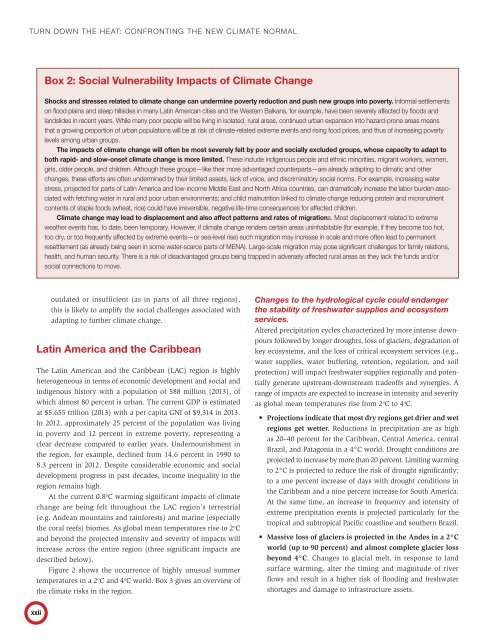1JF6e15
1JF6e15
1JF6e15
Create successful ePaper yourself
Turn your PDF publications into a flip-book with our unique Google optimized e-Paper software.
TURN DOWN THE HEAT: CONFRONTING THE NEW CLIMATE NORMAL<br />
Box 2: Social Vulnerability Impacts of Climate Change<br />
Shocks and stresses related to climate change can undermine poverty reduction and push new groups into poverty. Informal settlements<br />
on flood plains and steep hillsides in many Latin American cities and the Western Balkans, for example, have been severely affected by floods and<br />
landslides in recent years. While many poor people will be living in isolated, rural areas, continued urban expansion into hazard-prone areas means<br />
that a growing proportion of urban populations will be at risk of climate-related extreme events and rising food prices, and thus of increasing poverty<br />
levels among urban groups.<br />
The impacts of climate change will often be most severely felt by poor and socially excluded groups, whose capacity to adapt to<br />
both rapid- and slow-onset climate change is more limited. These include indigenous people and ethnic minorities, migrant workers, women,<br />
girls, older people, and children. Although these groups—like their more advantaged counterparts—are already adapting to climatic and other<br />
changes, these efforts are often undermined by their limited assets, lack of voice, and discriminatory social norms. For example, increasing water<br />
stress, projected for parts of Latin America and low-income Middle East and North Africa countries, can dramatically increase the labor burden associated<br />
with fetching water in rural and poor urban environments; and child malnutrition linked to climate change reducing protein and micronutrient<br />
contents of staple foods (wheat, rice) could have irreversible, negative life-time consequences for affected children.<br />
Climate change may lead to displacement and also affect patterns and rates of migrations. Most displacement related to extreme<br />
weather events has, to date, been temporary. However, if climate change renders certain areas uninhabitable (for example, if they become too hot,<br />
too dry, or too frequently affected by extreme events—or sea-level rise) such migration may increase in scale and more often lead to permanent<br />
resettlement (as already being seen in some water-scarce parts of MENA). Large-scale migration may pose significant challenges for family relations,<br />
health, and human security. There is a risk of disadvantaged groups being trapped in adversely affected rural areas as they lack the funds and/or<br />
social connections to move.<br />
outdated or insufficient (as in parts of all three regions),<br />
this is likely to amplify the social challenges associated with<br />
adapting to further climate change.<br />
Latin America and the Caribbean<br />
The Latin American and the Caribbean (LAC) region is highly<br />
heterogeneous in terms of economic development and social and<br />
indigenous history with a population of 588 million (2013), of<br />
which almost 80 percent is urban. The current GDP is estimated<br />
at $5.655 trillion (2013) with a per capita GNI of $9,314 in 2013.<br />
In 2012, approximately 25 percent of the population was living<br />
in poverty and 12 percent in extreme poverty, representing a<br />
clear decrease compared to earlier years. Undernourishment in<br />
the region, for example, declined from 14.6 percent in 1990 to<br />
8.3 percent in 2012. Despite considerable economic and social<br />
development progress in past decades, income inequality in the<br />
region remains high.<br />
At the current 0.8 o C warming significant impacts of climate<br />
change are being felt throughout the LAC region’s terrestrial<br />
(e.g. Andean mountains and rainforests) and marine (especially<br />
the coral reefs) biomes. As global mean temperatures rise to 2 o C<br />
and beyond the projected intensity and severity of impacts will<br />
increase across the entire region (three significant impacts are<br />
described below).<br />
Figure 2 shows the occurrence of highly unusual summer<br />
temperatures in a 2 o C and 4 o C world. Box 3 gives an overview of<br />
the climate risks in the region.<br />
Changes to the hydrological cycle could endanger<br />
the stability of freshwater supplies and ecosystem<br />
services.<br />
Altered precipitation cycles characterized by more intense downpours<br />
followed by longer droughts, loss of glaciers, degradation of<br />
key ecosystems, and the loss of critical ecosystem services (e.g.,<br />
water supplies, water buffering, retention, regulation, and soil<br />
protection) will impact freshwater supplies regionally and potentially<br />
generate upstream-downstream tradeoffs and synergies. A<br />
range of impacts are expected to increase in intensity and severity<br />
as global mean temperatures rise from 2 o C to 4 o C.<br />
• Projections indicate that most dry regions get drier and wet<br />
regions get wetter. Reductions in precipitation are as high<br />
as 20–40 percent for the Caribbean, Central America, central<br />
Brazil, and Patagonia in a 4°C world. Drought conditions are<br />
projected to increase by more than 20 percent. Limiting warming<br />
to 2°C is projected to reduce the risk of drought significantly:<br />
to a one percent increase of days with drought conditions in<br />
the Caribbean and a nine percent increase for South America.<br />
At the same time, an increase in frequency and intensity of<br />
extreme precipitation events is projected particularly for the<br />
tropical and subtropical Pacific coastline and southern Brazil.<br />
• Massive loss of glaciers is projected in the Andes in a 2°C<br />
world (up to 90 percent) and almost complete glacier loss<br />
beyond 4°C. Changes to glacial melt, in response to land<br />
surface warming, alter the timing and magnitude of river<br />
flows and result in a higher risk of flooding and freshwater<br />
shortages and damage to infrastructure assets.<br />
xxii


